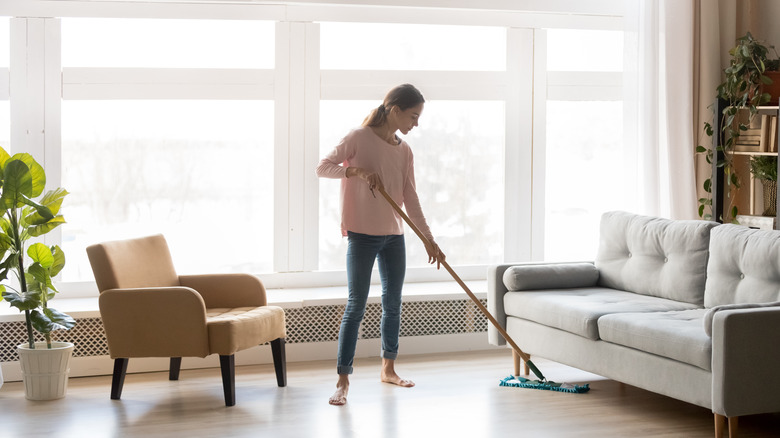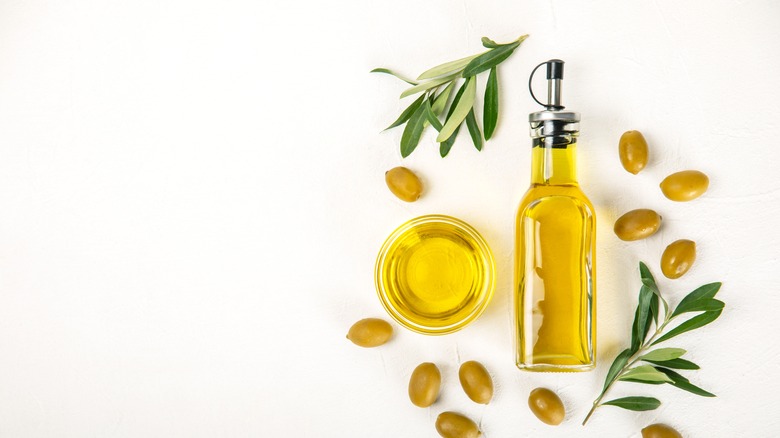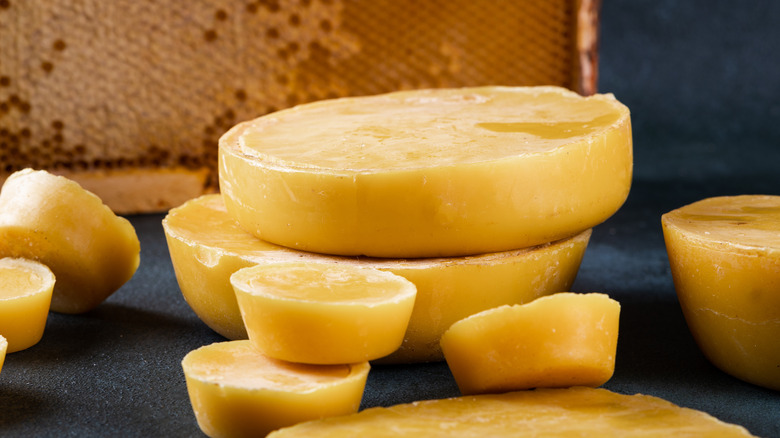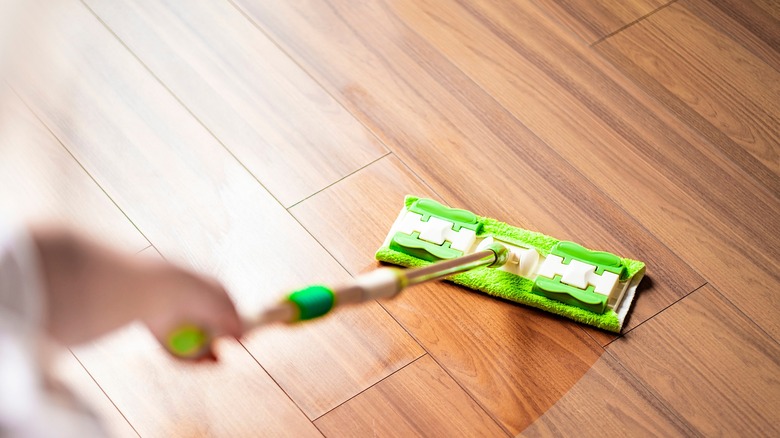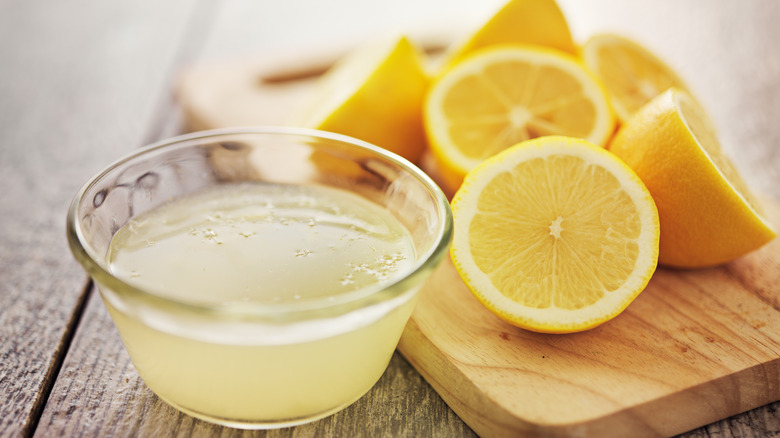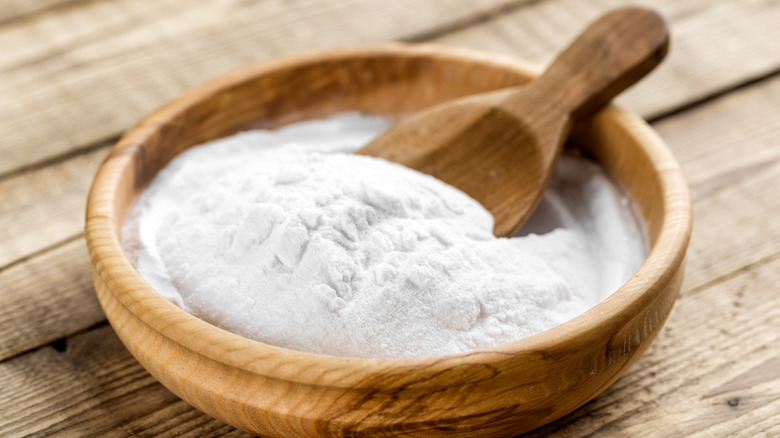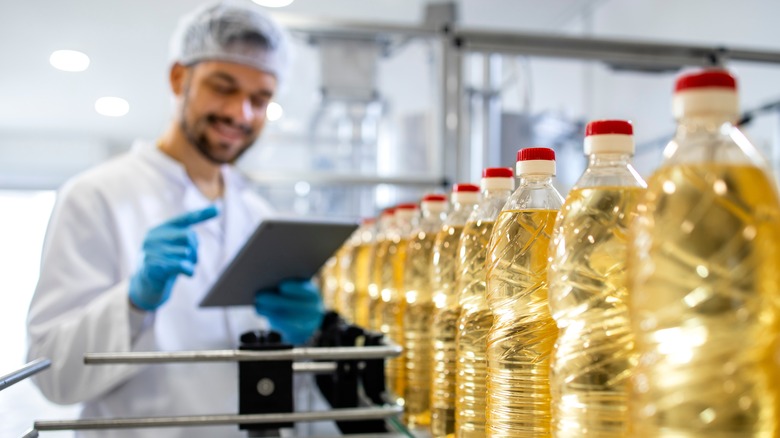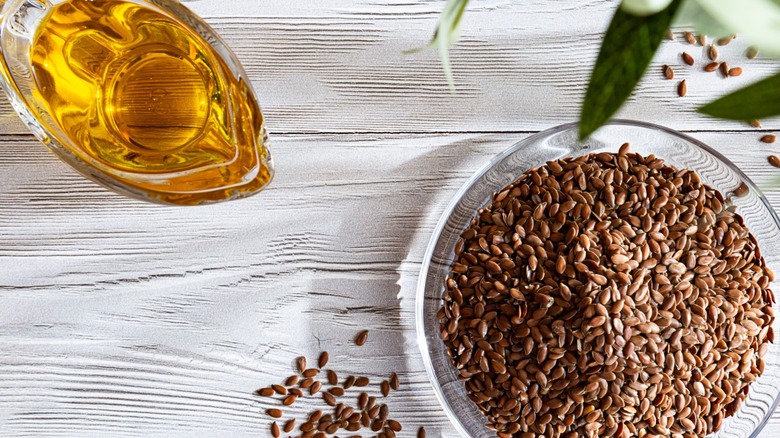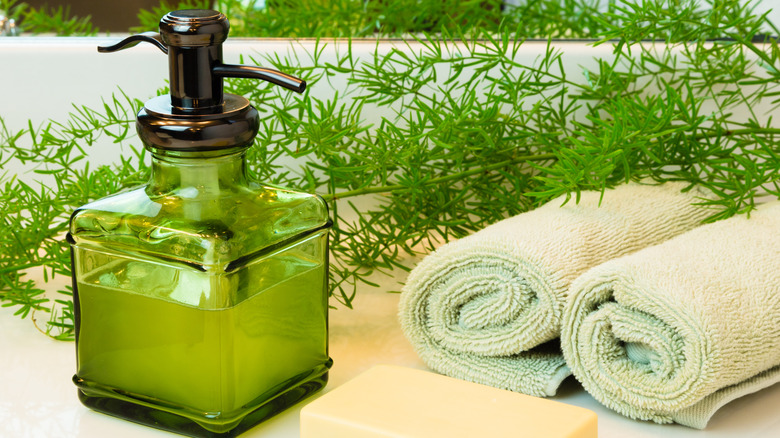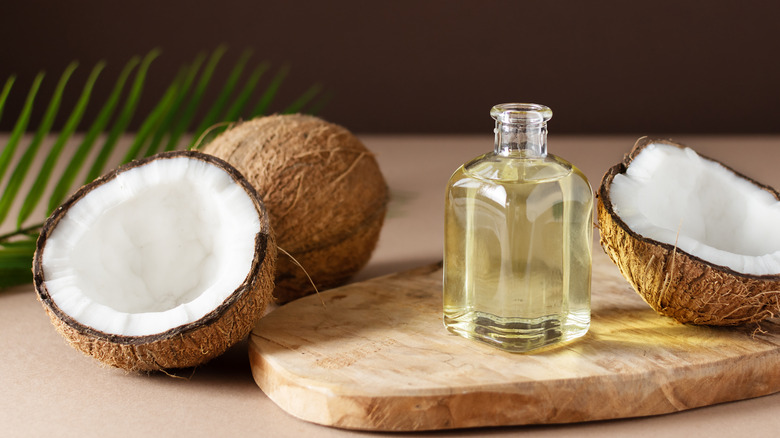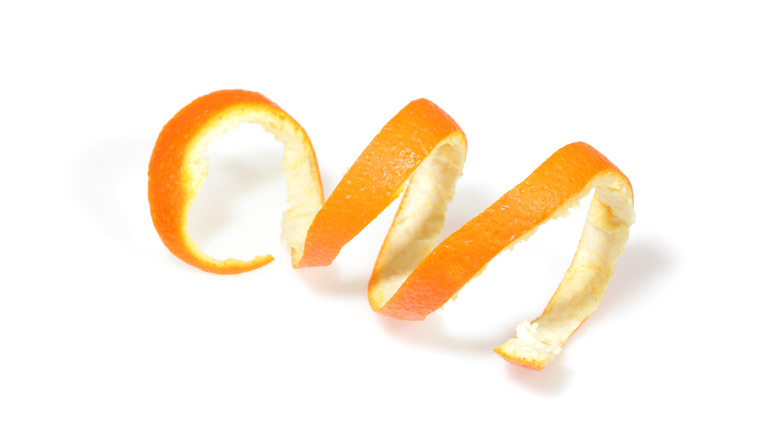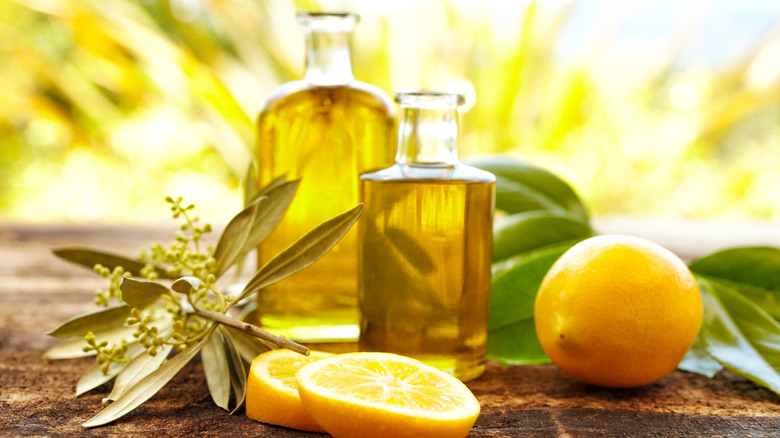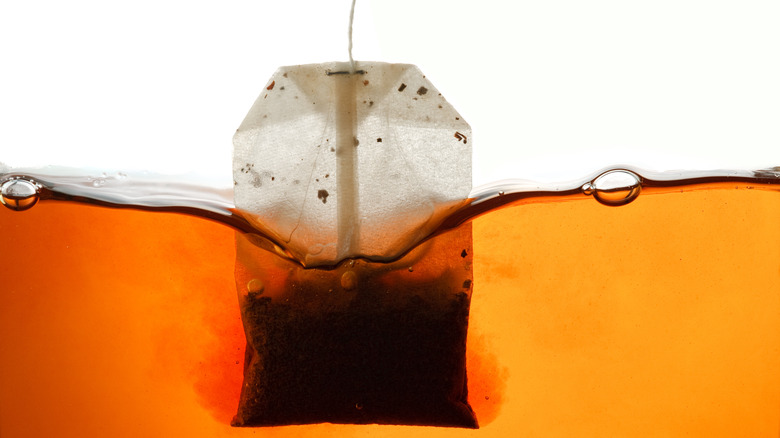Household Staples That Will Have Your Hardwood Floors Shining
For all their beauty and durability, hardwood floors become dull over time. Between dirt, grease, and scuff marks, wooden surfaces go through a lot. Even regular sweeping and vacuuming aren't enough to keep their glossy allure. If you don't like to use chemicals on your hardwood floors, you can replace commercial cleaning products with some ingredients from around your house. Some of these household staples are easy to apply on their own to clean and polish the floor, while others need to be mixed with other ingredients. Meanwhile, materials like baking soda should only be used in specific situations, such as when removing pet urine stains.
It's not always easy to keep your wood flooring looking like new. Before you apply your homemade solution, remove all the furniture and rugs, and sweep and vacuum the area. With a sponge or a microfiber cloth, apply the DIY polishing mixture starting from a corner of the room and work towards the door. Water can damage unsealed wooden floors and it leaves water stains on finished hardwood. So always watch out for damp spots and allow the floor to fully dry before bringing the furniture back. Read on to learn materials you can use on hardwood floors and how to apply them.
Olive oil
Olive oil is the first thing that comes to mind when you want to polish and rejuvenate hardwood flooring. It also works well with vinegar and water to clean stains or grease on the floor. To prepare this double-duty mixture, add a three-quarter cup of olive oil to a quarter cup of vinegar. Mix them into one gallon of warm water. To give the solution a nice fragrance, add 10 drops of your favorite essential oil. Dipping the sponge into the solution, squeeze the excess water out to make it damp. Apply the olive oil mixture with the damp sponge until you've covered the whole room. With a clean towel, buff the flooring to absorb any moisture and make the hardwood shine.
While the vinegar and warm water dissolve any grease or dirt stains on the hardwood, it's the olive oil that polishes the floor and restores its natural shine. Olive oil contains oleic acid, squalene, and phenolic compounds. Squalene seals the pores of the hardwood and gives the surface a slick and glossy appearance without making it sticky. The phenolic compounds replace the polyphenolics in the wood, which are lost because of foot traffic and temperature fluctuations. As with any solution that involves water, don't get the floor wet to prevent the boards from cupping.
Beeswax
Beeswax is another natural ingredient you can use to give your hardwood floor a good polish and make it smooth and scented. It also acts as a protective finish that prevents scratches and water damage. To prepare this wax polish, put 6 tablespoons of beeswax and 3 cups of walnut oil in a container and place it on top of boiling water to melt. You can replace the walnut oil with any plant-based oil you have at home. Stir well to mix the melting wax evenly into the oil, then put it aside for at least 10 minutes to set. To apply the polish, dip a clean cloth in the wax and rub it into the wood in a back-and-forth motion to avoid swirl marks. Allow it to dry, then buff it with another clean cloth.
Beeswax polish not only gives the wooden flooring a shine, but it also nourishes the hardwood. The ingredients are eco-friendly and biodegradable. They also pose no health risks to your household. That said, this polish should only be used on closed-grain hardwood floors such as cherry, pine, or hickory. Don't apply it on open-grained woods such as oak since the wax fills up the grain and turns white. Also, keep in mind that this polish isn't very durable, so you would have to reapply it regularly.
Vinegar
A bottle of vinegar is another easy way to bring some shine back into your hardwood floors. Vinegar cleans grime, dirt, and many stains on the wood. One of the easiest ways to use it on the wooden flooring is to mix it with water. But if you're dealing with grease and oil stains, you also need to add a few drops of dish soap to the recipe. To prepare your DIY wood floor cleaner, fill a bucket with a gallon of lukewarm water and add a cup of vinegar. Mix well and stir in a few drops of lavender essential oil to reduce the harsh vinegar odor. After dusting the floor, use a mop to apply the liquid to the floor and give it a thorough cleaning. To remove tough stains, use a sponge or microfiber cloth.
The acetic acid in the vinegar is a powerful agent that dissolves and removes stains. This solution works best on unsealed or unfinished hardwood floors. Don't use it on finished wood, since vinegar can strip off the finish. When in doubt, test the acidic liquid on a hidden corner of the floor first. If it doesn't affect the wood or make it look dull, then it's safe to proceed with your cleaning. After you finish mopping the floor, wipe off any damp areas with a clean cloth.
Lemon juice
Lemon juice is another ingredient to consider if your hardwood flooring is stained. But since the acidic juice can be too harsh for many wooden floors, you'll need the healing powers of olive oil to make this solution work. Together, the oil and the juice not only clean the floor but also make the hardwood shine. In a bucket full of 1 gallon of warm water, add a half cup of freshly squeezed lemon juice and a three-quarter cup of olive oil. Stir well, then use a sponge mop to apply the cleaning mixture. To avoid getting the floor wet, wring the mop before using it on the wood surface. Work from one side of the room to the other, then switch to an up-and-down direction to cover every inch of the flooring.
Lemon juice contains citric acid, which is used in many cleaning products. Adding the olive oil protects the hardwood against any damage the citric acid might cause. Always make sure that the floor is not damp or that you have pools of moisture in some areas. Before you air-dry the clean flooring, use a dry duster to remove any lemon juice residue or excess oil.
Baking soda
Baking soda is one of those household staples that you keep turning to over and over for its excellent stain-removing properties. But when applying it to hardwood floors, use it sparingly and only to treat scuff marks and deodorize and sterilize pet urine stains. To get rid of the offending odorous stains, mix equal portions of baking soda and water to make a thick paste. Dipping a clean cloth in the paste, spread it liberally on the affected area. Allow a few minutes, then wipe off the paste, along with the stain, with a damp cloth. For scratches, sprinkle the baking soda powder on the floor and use a sponge to scrub the scuff marks on the wood.
The active ingredient in baking soda is sodium bicarbonate. It dissolves chemical and acid stains and neutralizes undesirable odors absorbed in the wood. The powder is a gentle abrasive that both cleans and polishes the unfinished hardwood floor. However, when used on finished wood floors, baking soda can damage the finish and the sealants. After sprinkling the powder, make sure to vacuum the floor, then use a wet sponge to wash out any traces of the abrasive material.
Vegetable oil
Between dust, stains, and feet and paws padding around, hardwood floors lose their sheen quickly. Luckily, vegetable oil can nourish and restore the natural luster of the flooring. To give the recipe more oomph, add vinegar and essential oils to cleanse and deodorize the floor as well. You'll need 1 cup of vegetable oil, 1 cup of vinegar, and a few drops of essential oil. Fill a spray bottle with the ingredients and shake it well. Using a mop or a microfiber cloth, spray the mixture on the floor as you clean it. Work on the floor in small sections in the same direction as the wood grain until you're done. Since oil and vinegar don't mix well, you'll need to give the bottle a few shakes every time you spritz the floor. After cleaning the floor, use another cloth to buff the hardwood.
Besides its triple effect on the wood, there's another advantage to this recipe. It doesn't use water which spares your hardwood flooring the damage excess moisture can cause. On the other hand, you're using undiluted vinegar on the finished floor which could damage the finish of the hardwood. To preserve the integrity of the wood and reduce this risk, always mix equal amounts of vegetable oil and vinegar.
Linseed oil
Some oils are more suited to use on hardwood floors than others. Linseed oil is one of those materials to apply to your flooring without worrying about damaging it or even making it sticky. You can use this solution on unsealed wood floors since it's a lot safer than commercial cleaners and polishing products. The best part is that you don't have to measure out or mix ingredients. Just use the linseed oil alone to give your floor a rich sparkle. To apply it, add a few drops of the oil to a microfiber cloth, work it into the fabric to get it damp, then spread it evenly on the dust-free floor. Leave the thin coating on the wood for 10 minutes, then use a clean mop or a dry cloth to wipe it off and buff the floor.
Linseed oil works both as a cleaner and polisher of the wooden flooring. It's also ideal to fix a patchy finish on hardwood floors. The oil moisturizes the unsealed wood and gives it a nice coating that replaces the dull look with vigorous natural wood colors. Always use the food-grade variety of linseed oil to protect the children and pets in the household. To avoid staining the floor, don't let the oil sit on the unfinished wood for more than 10 minutes.
Plant-based liquid Soap
Plant-based liquid soaps, such as castile soap, are another option to clean hardwood floors. They're usually gentle on the flooring, don't leave residue, and won't damage the floor finish. To prepare the cleaning solution, fill a spray bottle with 1 teaspoon of unscented castile soap and 4 cups of warm water. If you want to give the floor a nice odor, add 10 drops of essential oil. Shake well, then spray it lightly on the floor. With a clean microfiber cloth work on the hardwood to remove any stains or odors. Every five minutes or so, stop cleaning and dry the treated parts of the floor with a clean cloth. Finally, rinse the floor with warm water using a mop.
Plant-based liquid soaps contain plant oils such as olive, hemp, or castor oil. These oils moisturize the hardwood and enrich the finish. Potassium hydroxide is the cleaning agent in the soap, and it helps soften stains on the wood. Always test the soapy water on a part of the floor to make sure it won't damage the wood. If the spray takes 30 minutes or more to dry, then it's too concentrated. Adding more water to the spray bottle should dilute the solution.
Coconut oil
When the hardwood floor ages, the boards become too thin with wear and tear. In that case, refinishing the floor isn't an option since sanding would damage the fragile boards. As an alternative, you can use coconut oil to refurbish the old flooring and give it a new lease on life. To prepare the mixture, add 1 cup of coconut oil to a half cup of lemon juice in a bowl. Stir the liquids until they mix well. Then, dab a soft sponge or a clean cloth in the liquid to get it damp. Working the solution into the floor, cover the area with a thin oily layer, then let it sit for five minutes. With a dry cloth, remove the excess oil and lemon residue and buff the floor to achieve a good shine.
Coconut oil is non-toxic and biodegradable. Thanks to its nourishing fatty acids, including lauric acid, it does a good job of fixing scratches and scuff marks on the wood. Moreover, the oil rehydrates and restores dry and worn-out wooden floors. You can use it safely on many hardwoods without worrying about changing their natural shade. It's also more than just a surface finish since the oil penetrates deep into the timber, making each application last longer.
Orange Peel
When you eat an orange, don't throw away the peel. You can make an efficient cleaning solution for your hardwood flooring with the rinds. Unlike other homemade wood cleaners, this one takes time to prepare. After peeling the orange, cut the peel into small pieces. In a glass jar, add the rinds, three drops of orange essential oil, and 1 cup of any vegetable oil you have at home. Pushing the rinds to the bottom and making sure they're well covered with the oil, place the lid on the jar. Keep it aside for a few days for the oils in the orange peel to release in the mixture. To use the liquid, apply a few drops to a clean cloth and buff the floor.
Orange peel contains volatile oils, including ethyl acetate, octanal, acetaldehyde, and ethanol, among others. These chemicals break down grime and grease stains on the wood and make it easy to clean the floor. Adding vegetable oil to the recipe gives the hardwood a good shine as well. If you don't have vegetable oil at hand, boil one orange rind in 1 cup of water. After it cools down, fill a spray bottle with the liquid and use it to clean the wooden floor.
Essential oils
Some essential oils are added to wood cleaners solely for their pleasant odors. But others contain the same chemicals you usually find in commercial floor cleaners. Some of the best candidates for this job include tea tree, lavender, lemongrass, cedarwood, lemon, orange, and eucalyptus essential oils, among others. To prepare the cleaning solution, mix 30 drops of the essential oil of your choice with a half cup of vinegar in a bucket. Next, add a gallon of warm water and stir well. Dunk a mop, sponge, or microfiber cloth into the bucket, squeeze it dry, then give the wood floor a good cleaning.
Different essential oils have specific cleaning properties. Both tea tree and lemongrass essential oils, for example, have antifungal qualities and will help you get rid of mold buildup on the floor. Lavender and eucalyptus oils are excellent ways to kill bacteria and keep the floor clean. You can also mix cedarwood and lemon essential oils to both clean and polish the hardwood flooring.
Black tea
Black tea is that kitchen staple that will perfectly clean your hardwood floors. And it's as easy as making a cup of tea. Fill a bucket with a gallon of warm water and drop three black tea bags in it. To protect the hardwood finish and give the solution polishing qualities, add a tablespoon of vegetable oil. Let the tea bags steep for 10 minutes before taking them out and disposing of them. Apply the solution to the wooden floor using a mop or cloth dampened into the liquid. Finally, wipe off any excess liquid on the wood and air dry it.
Although acidic, black tea is gentler on the wood than vinegar. It also contains astringent chemicals such as theaflavin, thearubigins, and caffeine, which dissolve oil stains and give the wooden floor a thorough cleaning. Moreover, theaflavin is antibacterial, so applying this brew will rid the floor of bacteria and pathogens. However, you shouldn't use this black tea solution on laminate wood floors. And since tea naturally stains, avoid applying it to light wood finishes. Don't spray the tea brew or let it sit on the floor since that would strip the wood finish and damage the sealant.
